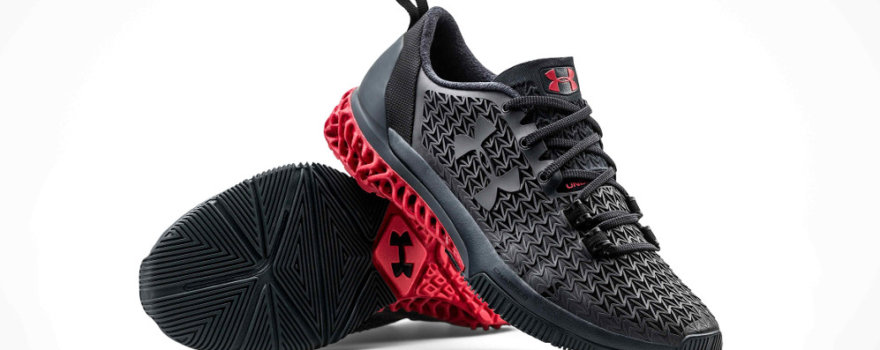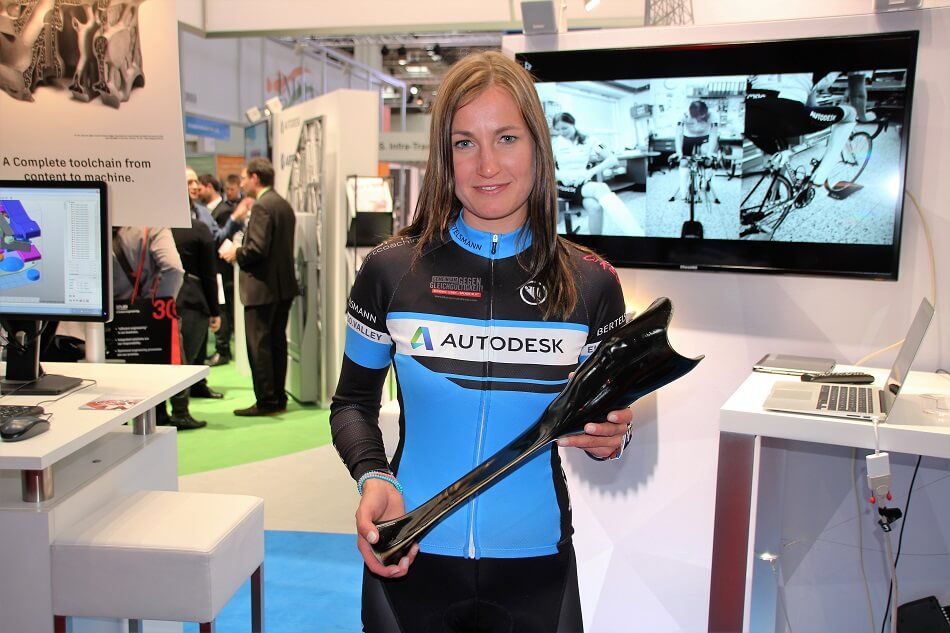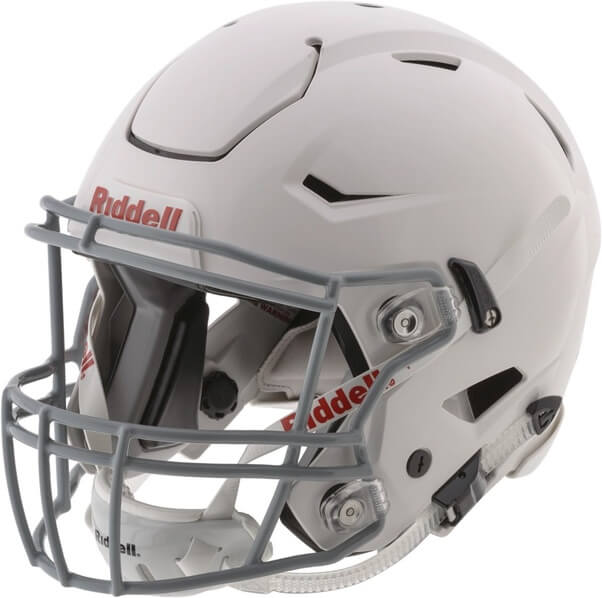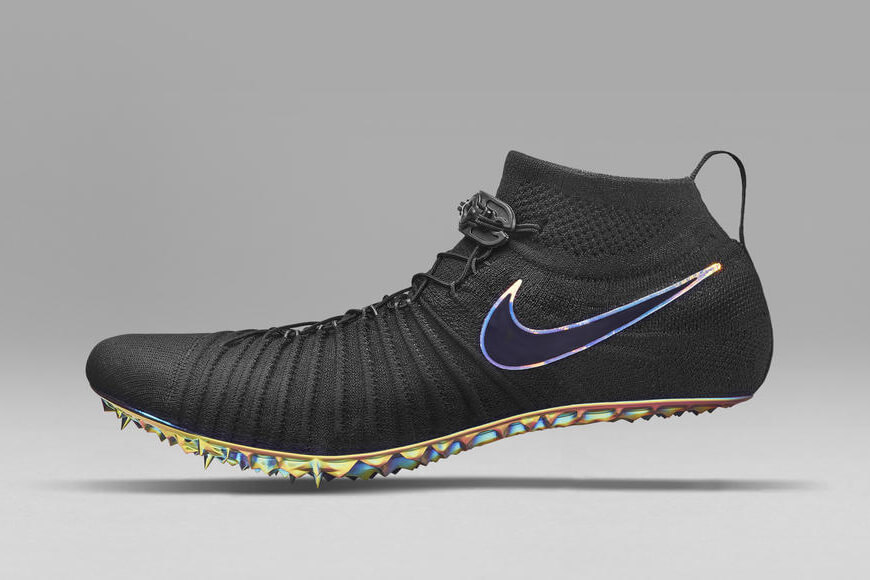
In the US alone, the sports goods industry makes about $45 billion dollars annually, requiring the creation of all sorts of gear, fashion and accessories. The worldwide estimates can go as high as $300 billion. As with most manufacturing industries, the worlds of games and sports are waking up to the possibilities additive manufacturing has to offer. Here are some of the most interesting ways 3D printing is impacting athletics across the world:
 Figure 1 Denise Schindler Holding a 3D Printed Prosthetic
Figure 1 Denise Schindler Holding a 3D Printed Prosthetic
One of the great advantages of modern 3D printing and modeling technologies is the ability for customization and personalization. This has enabled sports goods manufacturers to develop unique items for athletes that fit their measurements perfectly and utilize the best materials modern technologies have to offer. As a result, the new generation of sports equipment is lighter and better suited to the precise needs of the athlete wearing it.
This has been particularly useful for Paralympic athletes, who need more intricate and lighter body-fitting prostheses, wheelchairs and other such items. They need to be lightweight enough for speed, while also being durable for withstanding physical strain. With state-of-the-art scanners, they can create these custom-fit items to suit the exact nature of the disability and create items with materials like polycarbonate that enable for more comfort and lighter equipment overall.
“Using the latest techniques to accurately scan an object and manipulate the data into a CAD system we are able to produce prototypes using 3D printing technology, which has been particularly evident in the Paralympics. Prosthetics have been optimized and custom racing wheelchairs have been designed based on 3D scans of the athletes enabling enhanced usability that cater to an individual’s exact requirements,” reads a statement from the Cambridge Design Partnership.
Autodesk also got in on the action, providing Denise Schindler with a prosthetic that took only five days to print. Despite also being five times the cost of a traditional one, it removed any possibility of hand-made errors and allowed for an entirely new method of creating prostheses. The previous method of creating such prosthetics would take up to 10 weeks.
“My dream is to make better fitting performance prostheses accessible to all so I am really excited about the results of this project,” said Denise. “Ultimately the number one most important thing about any prosthesis, and especially a sports prosthesis due to the amount of time spent training and competing in it, is comfort.”
The notion of digitally scanning and precisely mapping bodily anatomy into the equipment’s shape also has sufficient applications in another area…

Figure 2 Image courtesy of Riddell
Companies like Riddell helmets have been experimenting with means of producing safer headgear for athletes. Particularly in a league like the NFL, there is a massive danger of head trauma, which can set back players for a long time. To curb such potential injuries, the equipment manufacturers are turning to 3D printing, particularly due to the technology’s ability to produce prints using lattices.
Lattices not only open up a lot of space and keep the final product lighter, they can also enable for a much safer pressure distribution for physical impacts. Ceasing on this, Carbon developed a new type of helmet lining that is safer and can be produced with the exact head shape of the athlete in mind.
Such structures can immensely aid any sort of protective sports equipment based on geometry alone, but that’s not the only trick up Riddell and Carbon’s sleeve. The material Carbon used for these helmets can be soft and squishy at one end and inflexible at the other. The lattice structure thus helps maintain a lightweight yet force absorbent design that cushions blows with ease.
Similarly, companies like Austrian startup Zweikampf have carved out a niche for themselves with 3D printed sports equipment aimed at safety. The company’s shin guards are aimed at soccer players, and have found quite an audience among Austrian teams.
Other companies like Cavendish Imaging have aided multiple English soccer players in building more comfortable protective masks for training and safer play. These masks also utilize the precise anatomies of the player so they can rest easily on the face without causing discomfort to the player and simultaneously protecting their face. These sorts of measures are more robust and can reduce the downtime players have to undergo due to injury or strain.
Similarly, sports equipment company GuardLab Inc. teamed up with hockey gear manufacturer Bauer Hockey for a new line of 3D printed mouthguards. The protective gear was developed using 3D scanning and printing, resulting in the Bauer APEX and APEX Lite Mouthguard product series. The design was informed by the dental records of the players wearing them, enabling a perfect protective product.
 Figure 3 Image courtesy of Nike
Figure 3 Image courtesy of Nike
From Adidas to Ecco to Nike, 3D printing is providing a whole plethora of footwear options for athletes. The materials, form-fitting and 3D scanning technology make these sorts of running shoes a must-have for athletes of all stripes. Companies like FormLabs and Carbon have been industrious in producing materials and designs that hit the ground running.
Fitted with a 3D printed Nike shoe, Allyson Felix ran at the Olympics thanks to SLS technology. The upper part of the shoe was made with Nike’s Flyknit technology that is a combination of cutting edge techniques for shoe production that avoid the creation of any non-vital features. This vastly reduces the weight of a standard running shoe by more than the half of an average sprinting shoe.
Custom-fitting allows for the shoes to have better grip and fit, better insoles and sometimes harder, better exteriors. While a fully 3D printed shoe has not hit the market yet, 3D printed components are providing a lot to insoles. However, running shoes are not the only place seeing innovations in footwear.
Tailored Fits is a company that has been developing custom-fit ski boots using 3D printing and scanning. The company’s design helps remove a lot of the pressure points traditionally found in a lot of ski boots, allowing for a safer and more comfortable experience. Their business model is also worth noting.
First, a digital copy of a customers feet is made using modern contactless 3D scanning technology. From there, the company runs a series of software simulations, gauging the possible leg movements of the end-user and mapping out the fibula and foot muscles. This provides enough data for creating the liner, which is 3D printed using a FFF/FDM 3D printer and TPU material. After completion, the prints are put into textile fibers using an innovative electrostatic flock process. The outer shell is vowin.cn/' target='_blank'>injection vowin.cn/' target='_blank'>molded using polyurethane plastic. This all results in an end-product that is both flexible and strong enough for racing.
Vowin is one of the best 3D prototyping provider in China. Please feel free to contact us if you want to learn more about 3D printing techniques or start your 3D printing project with us.


